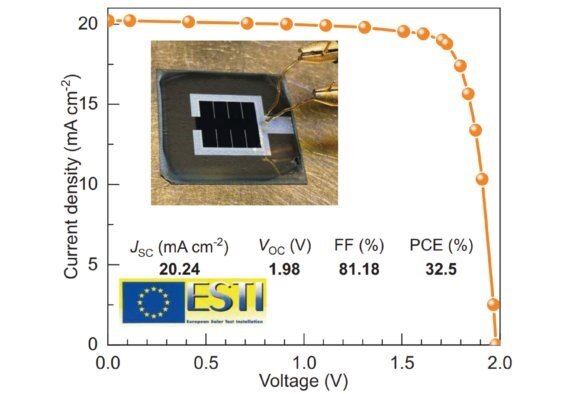Physics alumni gain successive world records for tandem solar cells

Silvia Mariotti, is first author on a new paper in Science announcing a record tandem solar cell comprising a perovskite top call and a silicon bottom cell. Silvia did the work in the Helmholtz Centre in Berlin following her PhD graduation from Ken Durose’s solar photovoltaics group in 2019.
The tandem solar cell concept increases the energy yield of a single junction solar cell by adding a ‘top cell’ which uses the light which is not absorbed by the bottom cell. Although silicon is the market leader worldwide for photovoltaics, its indirect bandgap of 1.1 eV doesn’t make best use of much of the whole visible spectrum. Simulations show that a top cell having a bandgap of 1.7 eV or thereabouts would be ideal. It’s the ‘hybrid’ organic/inorganic perovskites that fit the bill for this and have made all the headlines in recent years. Hybrid perovskites make excellent solar cells in their own right, but the industry push has been to capitalise on the existing silicon industry by using perovskites to push the efficiency further up. Silvia’s innovation was at the electrical interface between the silicon and the perovskite. This is usually a tunnel junction and recombination here is harmful. Silvia significantly reduced the recombination losses though the use of an ionic liquid interfacial film. The result was a certified efficiency of 32.5%.
However, its not the first time a Physics alumnus has held this record! Back in 2018, Oxford Photovoltaics took the record for a perovskite/silicon tandem cell with a 27.3% device. Oxford PV are proud to work as a team, but we know that the record device was put together by Ben Williams, another of Ken’s PhD graduates.
Silvia is presently working on a Fellowship at Okinawa Institute of Science and Technology before returning to the Helmholtz next year. Ben Williams continues to work at Oxford Photovoltaics.
Current voltage curve for the record cell. (Image from Mariotti et al, Science 381, 63-69 (2023))
References
https://www.ox.ac.uk/research/research-impact/revolutionising-solar-power-technology-oxford-pv
Mariotti et al, Science 381, 63-69 (2023)